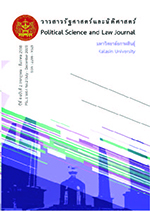Anti-CorruptionFactors Influence to Corruption Behaviors in Local Government in Northeast Thailand: Study in the Sub-District Administrative Organizations
DOI:
https://doi.org/10.14456/gjl.2015.19Keywords:
คอร์รัปชัน, ปัจจัยต่อต้านการคอร์รัปชัน, พฤติกรรมคอร์รัปชัน, องค์การ บริหารส่วนตำบล, Corruption, Anti-Corruption, Behaviors, Sub-District Administrative OrganizationsAbstract
บทความนี้มีวัตถุประสงค์เพื่อศึกษา (1) ปัจจัยการต่อต้านการคอร์รัปชัน และพฤติกรรมการคอร์รัปชันในองค์การบริหารส่วนตำบล (2) เปรียบเทียบพฤติกรรม การคอร์รัปชันจำแนกตามบุคลากรสายการเมืองและสายข้าราชการ (3) เปรียบเทียบ พฤติกรรมการคอร์รัปชันจำแนกตามขนาดขององค์การเล็ก กลาง และใหญ่ และ (4) อิทธิพลของปัจจัยการต่อต้านการคอร์รัปชันที่มีต่อพฤติกรรมการคอร์รัปชัน กลุ่ม ตัวอย่างคือ องค์การบริหารส่วนตำบล (อบต.) ในภาคตะวันออกเฉียงเหนือจำนวน 338 แห่ง จากประชากรทั้งหมด 2,205 แห่ง ใช้วิธีการเลือกตัวอย่างแบบชั้นภูมิ แบบ เป็นระบบ และแบบเจาะจง แบบสอบถามถูกสร้างจากทฤษฎีการคอร์รัปชันและ แนวคิดการต่อต้านคอร์รัปชัน ตัวแปรอิสระและตัวแปรตามมีค่าความเชื่อมั่นเท่ากับ 0.978 และ 0.935 ตามลำดับ ส่วนการวิเคราะห์ข้อมูลใช้สถิติ ค่าร้อยละ ค่าเฉลี่ย ค่า เบี่ยงเบนมาตรฐาน การวิเคราะห์ค่าที การวิเคราะห์ความแปรปรวน และการ วิเคราะห์การถดถอยแบบพหุคูณโดยใช้เทคนิควิธีการสเต็ปไวส์ ผลการวิจัยพบว่า 1. เรื่องปัจจัยต่อต้านการคอร์รัปชัน ทั้งนักการเมืองและข้าราชการ (หรือนายกและ ปลัด อบต.) ปฏิบัติตามปัจจัยต่อต้านการคอร์รัปชันในภาพรวมในระดับสูง เรียงจาก มากไปน้อย ได้แก่ การยึดหลักคุณธรรม การยึดหลักความโปร่งใส การยึดหลักถูก ตรวจสอบได้ การยึดหลักนิติธรรม การยึดหลักมีส่วนร่วม การยึดหลักความรับผิดชอบ การยึดหลักความคุ้มค่า การยึดหลักมีเหตุผล การยึดหลักความรู้ การยึดหลักพึ่งพา ตนเอง การลดการผูกขาดอำนาจ การมีภูมิคุ้มกันในตัวเอง และการยึดหลักความ พอประมาณ แต่ยึดหลักการจำกัดการใช้ดุลยพินิจในระดับปานกลาง ส่วนในเรื่อง พฤติกรรมการคอร์รัปชันนั้น ทั้งนักการเมืองและข้าราชการมีพฤติกรรมการคอร์รัปชัน ทางการบริหารในระดับต่ำ มีพฤติกรรมการคอร์รัปชันทางการเมืองในระดับต่ำมาก และมีพฤติกรรมการคอร์รัปชันทางเศรษฐกิจในระดับต่ำมาก 2. นักการเมืองและ ข้าราชการมีความเห็นต่อพฤติกรรมการคอร์รัปชันแตกต่างกันอย่างมีนัยสำคัญทาง สถิติ โดยที่ (1) นักการเมืองมีความเห็นว่ามีการคอร์รัปชันทางการบริหารในระดับต่ำ มาก แต่ข้าราชการกลับมีความเห็นว่ามีการคอร์รัปชันทางการบริหารในระดับปาน กลาง (2) นักการเมืองมีความเห็นว่ามีการคอร์รัปชันทางการเมืองในระดับต่ำมาก แต่ ข้าราชการกลับมีความเห็นว่ามีการคอร์รัปชันทางการเมืองในระดับต่ำ และ (3) นักการเมืองมีความเห็นว่ามีการคอร์รัปชันทางเศรษฐกิจในระดับต่ำมาก แต่ข้าราชการกลับมีความเห็นว่ามีการคอร์รัปชันทางเศรษฐกิจในระดับต่ำ 3. องค์การ บริหารส่วนตำบลทั้งขนาดเล็ก ขนาดกลาง และขนาดใหญ่มีความเห็นต่อพฤติกรรม คอร์รัปชันแตกต่างกันอย่างมีนัยสำคัญทางสถิติ โดยที่ (1) องค์การขนาดใหญ่ มีพฤติกรรมการคอร์รัปชันทางการบริหารมากกว่าองค์การขนาดกลางและเล็ก และ องค์การขนาดกลางก็มีการคอร์รัปชันทางการบริหารมากกว่าองค์การขนาดเล็ก (2) องค์การขนาดใหญ่มีการคอร์รัปชันทางการเมืองมากกว่าองค์การขนาดกลางและ เล็ก และองค์การขนาดกลางก็มีการคอร์รัปชันทางการเมืองมากกว่าองค์การขนาดเล็ก และ (3) องค์การขนาดใหญ่มีการคอร์รัปชันทางเศรษฐกิจมากกว่าองค์การขนาดกลาง และเล็ก และองค์การขนาดกลางก็มีการคอร์รัปชันทางเศรษฐกิจมากกว่าองค์การ ขนาดเล็ก และ 4. ปัจจัยต่อต้านการคอร์รัปชันที่มีอิทธิพลต่อพฤติกรรมการคอร์รัปชัน แต่ละประเภท พบว่า (1) ปัจจัยต่อต้านการคอร์รัปชันที่มีอิทธิพลต่อพฤติกรรมการ คอร์รัปชันทางการบริหาร ได้แก่ การยึดหลักความโปร่งใส และการจำกัดการใช้ดุลยพินิจ (2) ปัจจัยต่อต้านการคอร์รัปชันที่มีอิทธิพลต่อพฤติกรรมคอร์รัปชันทางการเมือง ได้แก่ การยึดหลักความโปร่งใส การลดการผูกขาดอำนาจ การยึดหลักคุณธรรม และ การยึดหลักพึ่งพาตนเอง และ (3) ปัจจัยต่อต้านการคอร์รัปชันที่มีอิทธิพลต่อ พฤติกรรมการคอร์รัปชันทางเศรษฐกิจ ได้แก่ การยึดหลักความโปร่งใส การลดการ ผูกขาดอำนาจ การยึดหลักความรู้ และการยึดหลักความรับผิดชอบThis Article was undertaken to assess the level of anticorruption factors and corruption behaviors in the sub-district administrative organizations (SAOs). This study compared the perception in the political and official fields of SAOs. Furthermore, it also tried to compare the perception with the small, medium and large obligation sizes of the SAOs. Lastly, it also investigated the influence of the anticorruption factors on the corruption behaviors. The samples of this study were 338 sub-district administrative organizations (SAOs) which were selected from the 2,205 populations in Northeast Thailand. Sampling methods were stratified random, systematic, and purposive sampling. Questionnaires of this study were adopted from the corruption theories and the anti-corruption. The reliability of independent and dependent factors was respectively 0.978 and 0.935 respectively. The statistical methods employing were as follows: the percentage, mean, standard deviation, t-test, analysis of variance (ANOVA), and multiple regressing analysis (MRA) which operated by stepwise regression technique. The finding of this study revealed the following. 1. In case of anti-corruption factors: the overall practice of anti-corruption factors behaved by politicians and the officials was a high level which classified as a high level along integrity, transparency, accountability, rule of law, participation, responsibility, efficacy, reasonableness, knowledge holding, self-dependency, demonopoly, self-immunity, and moderation while de-discretion was a moderate level. The corruption behaviors performed by politicians and officials was the different level which distinguished as a low level along administrative corruption, a very low level along political corruption and a very low level along economic corruption. 2. There were significant differences between the politicians’s views and the officials’ views in terms of the corruption behaviors such as: (1) The politicians assumed that administrative corruption behaviors were at a very low level, but on the other hand the officials assumed that administrative corruption behaviors were at a moderate level. (2) The politicians assumed that political corruption behaviors were at a very low level, but the officials assumed that political corruption behaviors were at a low level. And (3) The politicians assumed that economic corruption behaviors were at a very low level, but the officials assumed that economic corruption behaviors were at a low level. 3. There were significant differences between the small SAOs, medium SAOs, and large SAOs in terms of their corruption behaviors. These differences implied as follows: (1) The existing administrative corruption of the large SAOs was higher than both the medium SAOs and the small SAOs, and moreover the administrative corruption of the medium SAOs was higher than the small SAOs. (2) The existing political corruption of the large SAOs was higher than both the medium SAOs and the small SAOs, and moreover the political corruption of the medium SAOs was higher than the small SAOs. Lastly (3) The existing economic corruption of the large SAOs was higher than both the medium SAOs and the small SAOs, and moreover the economic corruption of the medium SAOs was higher than the small SAOs. And 4. There was a significant influence from the anti-corruption factors on the corruption behaviors. These explanations were as follows: (1) The two anti-corruption factors which reduced administrative corruption most effectively were transparency and dediscretion. (2) The four anti-corruption factors which effectively influenced political corruption were transparency, de-monopoly, integrity, and self-dependency. And lastly (3) The four anti-corruption factors which effectively influenced economic corruption were transparency, de-monopoly, knowledge conduct, and responsibility.
Downloads
Downloads
Published
How to Cite
Issue
Section
License
Copyright (c) 2017 วารสารการบริหารปกครอง (Governance Journal) มหาวิทยาลัยกาฬสินธุ์

This work is licensed under a Creative Commons Attribution-NonCommercial-NoDerivatives 4.0 International License.








